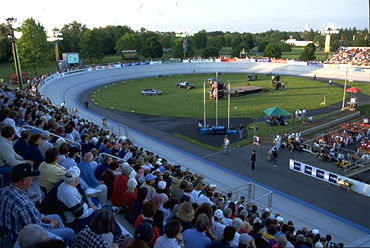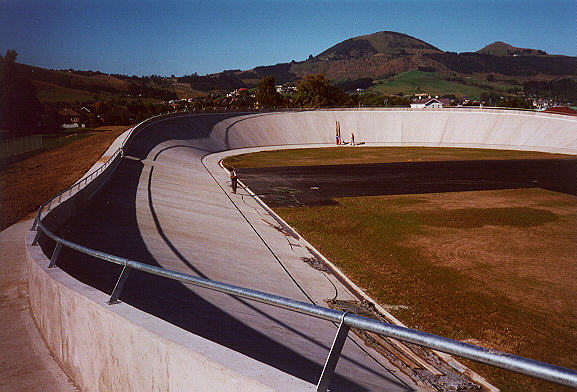
Racing Terms
Here
are explanations of some terms commonly used to describe bicycle racing.
∑
Blue band - or
"cote d' azure"
∑
Red Line
∑
Kilometer ďKilo" or 1000 meter time trial
∑
Pursuit
∑ Drafting
Stoker
The
stoker is the rider on the rear seat of a tandem. Although this is sometimes referred
to as the power position, that does not necessarily mean that one rider is
working any harder than the other. Since the rear riderís position has a more
direct connection to the rear wheel, a smaller percentage of his or her power
output is lost in the mechanical inefficiencies of the bike.
Tandem
Captain
The rider on the front
seat of a tandem bike who is often also referred to as the driver or pilot.
Tandem Gender Categories
Tandem teams are usually classified
in three gender categories. Menís: two male riders. Womenís: two female riders.
Mixed: one male and one female rider; there is no distinction based on which
one is driving.
Velodrome
A steeply banked,
oval-shaped track designed for bike racing. They are built in a variety of
sizes, with lap distances ranging from around 160 meters to 500 meters. The two
most common lengths are 250 meters and 333.33 meters. Long tracks, 333 meters
and longer, most frequently have concrete surfaces whereas short tracks are
most often made of wood. A typical 333 meter track will have somewhere between
twenty-eight and thirty-five degree banking at the apex of the turn. However, a
250-meter track will likely have somewhere between forty-two and forty-eight
degree banking. The steeper the banking the faster one must ride in order to
keep from sliding off the track. There are fewer than two dozen operational
bike tracks left in the United States today. Prior to World War II, there were
several hundred. In Europe and Australia, track racing is much more popular and
there are many more velodromes.
Track Bike
Also known as a
fixed-gear bike, it is designed to be lightweight and efficient. There is only
one gear on the bike; many people would call it a one-speed. There is no free-wheel
action built into the drive train. So, if the rear wheel is rolling, the pedals
must be moving two. Thus, if you were to pedal backward, the bike would move
backward.
Blue band - or "cote d' azure"
The 20-centimeter wide band of blue paint
at the bottom edge of a velodrome surface. It's
out-of-bounds at anything but the slowest of speeds.
Black Line
This is the lowest line on a velodrome surface. Also referred to as the pole line or
measurement line, it is the line that determines the measurement of the track.
For example, a 250-meter track is 250 meters when measured at the pole line.
This line also marks the inside edge of the pole lane (the sprinters lane).
Red Line
Painted
one meter above the black line on the velodrome surface, this line marks the outside edge of
the pole lane (sprinter's lane). Once a sprint is fully engaged (riders are
near top speeds), and a rider enters the pole lane, the rider is not allowed to
leave the lane (ride above the red line) to attempt to impede the progress of
his or her opponent.
Blue Line
This
is the blue line painted in the middle of the velodrome
surface. It is also known as the stayersí line. Slow-moving riders in training
and relief riders in the madison race are required to stay above this line.
Kilometer
ďKilo" or 1000 meter time trial
This is a velodrome race that is often thought of as the ultimate
test of a riderís speed and strength. Competitors try one by one to cover 1000
meters (four laps on a 250 meter track) in as little time as possible.
Depending on the riderís strengths and weaknesses, basic strategies range from
blasting off the line with a brutally quick start, reaching top speeds in less
than a lap and then holding on for dear life as the pain sets in, to delivering
a smooth metered starting effort followed by constant acceleration for four
laps.
Match sprint
This velodrome race is a very strategic and technical event
that involves two bikes stalking each other for approximately 1,000 meters at
low speeds as they intensely watch for the perfect opportunity to surprise their
opponent with an explosive acceleration.†
The remaining distance is an all out high-speed sprint to the finish
line. Since only two bikes
race at a time, sprint tournaments consist of multiple elimination rounds.
Championship formats are never single elimination; a rider must lose more than
once to be kept from advancing. Riders are seeded in a tournament's start list
based on a qualifying ride. The standard qualifier is a flying 200-meter time
trial.
Pursuit
Two bikes start on
opposite sides of the velodrome and chase each other
for a given distance. If one rider catches the other before they have gone the
full distance, the race ends immediately. The race goes the full distance if
neither rider catches their opponent, and is won by the rider who covers the
distance in the least amount of time. Like match sprints,
since only two bikes race at a time, riders compete in a tournament format.
Unlike match sprints, the tournament format consists of single elimination
rounds. Women and mixed tandem categories ride 3000 meters whereas men's
competition covers 4000 meters.
Time Trial
Each rider attempts to
cover a specified distance in the minimum amount of time. Riders are assigned
start times and ride by themselves; drafting is not
allowed.
Mass Start Event
Any race where
multiple riders come to the same start line all at the same time. This
contrasts with individual events, such as time trials,
or the pursuit where two riders start at two different
start lines. Mass start events are common in all forms of bike racing: road,
track, and off-road.
Road
Race
A long distance mass start event on the road. Sometimes, riders will race
multiple times around a several mile course (a circuit race). Other times they
will race once around a very long loop. Or, they may race from one point to
another (a point-to-point course). Elite and pro menís courses are rarely
shorter than eighty miles and are more often over a hundred. Elite or pro
womenís races are rarely shorter than 50 miles and are commonly sixty-five to
ninety miles.
Criterium (or crit)
A road race conducted
on a very short circuit, usually in the neighborhood of 0.7 to two miles. They
are often run around a few city blocks and have several corners. They tend to
be flatter and shorter than other types of road races. They are often very
technical from the bike handling perspective because of the frequent cornering.
Total distances range widely from ten or fifteen miles to fifty or so.
Stage Race
A series of
consecutive road events grouped together into a single large competition. Small
stage races may be held over two or three days and have only a few stages. Very
large stage races, like the Tour de France, span several weeks and may
incorporate a few rest days. There are usually a variety of types of stages,
including road races, time
trials, and sometimes criteriums. Each stage is timed and the overall
winner will be the rider with the fastest total time.
Drafting
Also known as sitting-on or
grabbing a wheel, one rider rides in the slipstream of another, protected from
the wind. This usually means riding very close together, often with wheels only
a few inches from one another. Drafting can reduce required energy expenditure
by as much as thirty percent. This fact is one of the major factors in racing
strategy.
